Tremolo vs Chromatic Harmonica: Which One Should You Choose?
The difference between tremolo vs chromatic harmonica is easy to spot once you know what each one does.
A tremolo harmonica uses two reeds for every note, one slightly sharp and one slightly flat, so the sound has a wavy, shimmering effect. It’s the type of harmonica you’ll often hear in folk music across Asia and Europe, where that soft pulsing tone feels natural.
A chromatic harmonica works differently. It has a slide button that lets you reach every note in the twelve tone scale. That makes it a favorite in jazz, classical, and even pop music, because you don’t need to switch instruments when a song changes key.
You’ll discover how each works, their pros and cons, which music suits them best, and what learning curve to expect. This guide helps you pick the right harmonica for your musical journey.
What is the difference between tremolo vs chromatic harmonica?
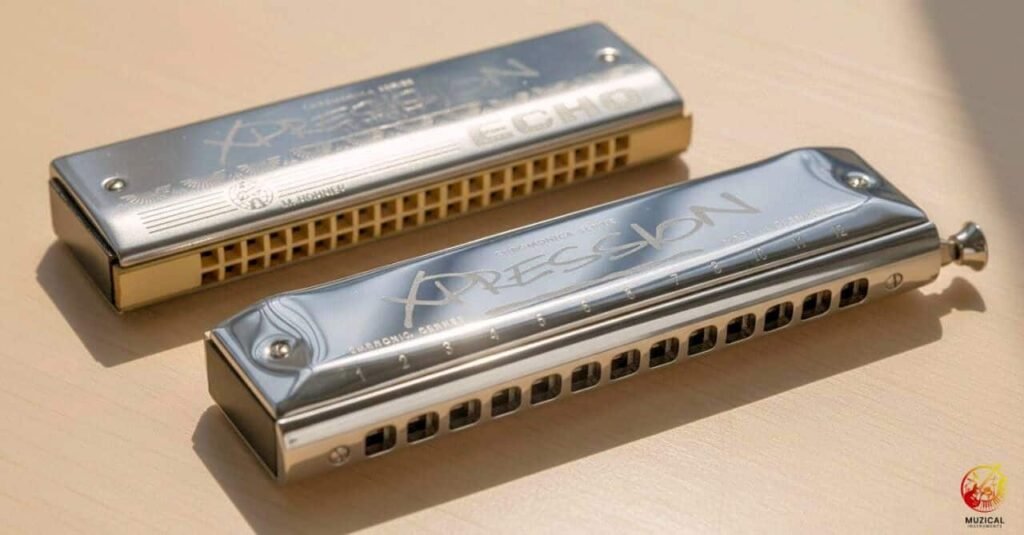
The core difference lies in how they produce sound. Tremolo harmonicas house two reeds per note, one tuned exactly on pitch, the other slightly sharp or flat. When you play, both reeds sound together, creating that distinctive vibrato effect automatically.
Chromatic harmonicas use a slide mechanism instead. Press the button and air redirects to sharp/flat reeds. Release it and you get natural notes. This gives you all twelve notes of the Western scale, every sharp and flat you need.
The tremolo’s double reed setup makes every note shimmer. Think of Irish folk tunes or Asian traditional music, that warbling quality comes from tremolo instruments. The effect happens naturally, no special technique needed.
Chromatics sacrifice the tremolo effect for complete note access. Jazz players love them because they can navigate complex chord changes without switching harps. Classical arrangements become possible when every accidental is available.
| Feature | Tremolo | Chromatic |
|---|---|---|
| Reeds per Note | 2 (paired) | 1 natural + 1 sharp/flat |
| Button Operation | None | Slide button required |
| Built-in Vibrato | Automatic | None |
| Key Flexibility | Limited | Complete chromatic scale |
How Do These Harmonica Types Actually Work?
Tremolo harmonicas organize reeds in upper and lower chambers. The top chamber holds the exact pitch reed, while the bottom houses the slightly detuned partner. Most players cover both chambers when playing, letting both reeds sound simultaneously.
This creates the beating pattern we hear as tremolo. The slight pitch difference, usually 10-20 cents, makes the combined sound wobble at a specific rate. Faster air flow can minimize the effect, while gentle playing maximizes it.
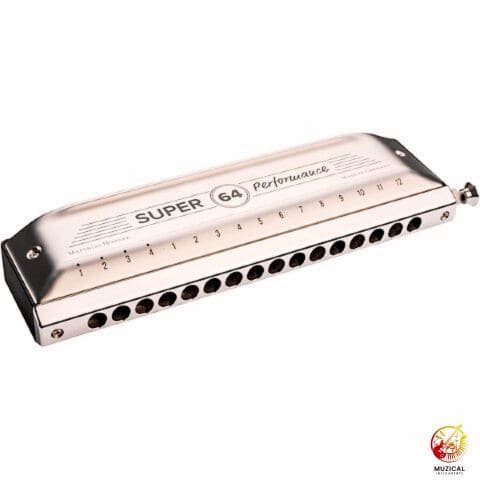
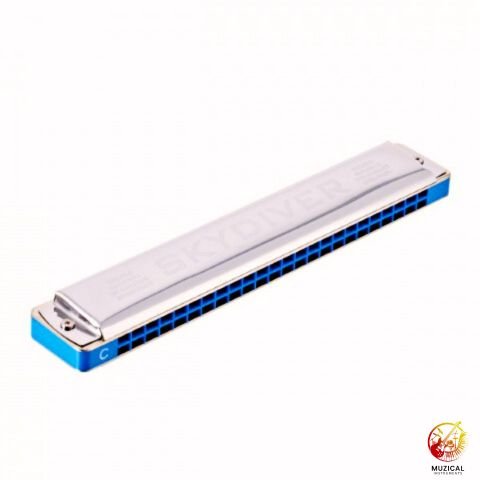
Chromatic harmonicas contain two complete reed sets. One plays natural notes (C, D, E, F, G, A, B), the other handles sharps and flats. A spring loaded slide decides which set gets your breath.
The slide mechanism requires precise manufacturing. Air leaks ruin the sound, so quality chromatics need tight tolerances. This complexity explains why decent chromatics cost more than tremolo models.
Pro Tip: Practice slide timing slowly on chromatics. Many beginners rush button changes, creating sour notes that kill musical phrases.
Which Musical Styles Suit Each Harmonica Best?
Musical genre often determines your best choice. The tremolo vs chromatic harmonica decision usually comes down to what you want to play.
Tremolo harmonicas dominate folk traditions worldwide. Celtic music uses them for haunting airs and driving dance tunes. Eastern European folk embraces their ability to mimic traditional string instruments. Chinese and Japanese music features tremolo extensively in both classical and popular arrangements.
Country music, especially older styles, relies heavily on tremolo harmonicas. The vibrato adds emotion to simple melodies. Gospel and spiritual music benefit from the tremolo’s choir-like quality on sustained notes.
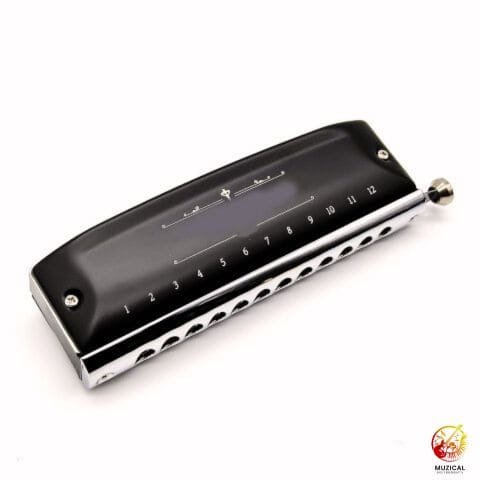
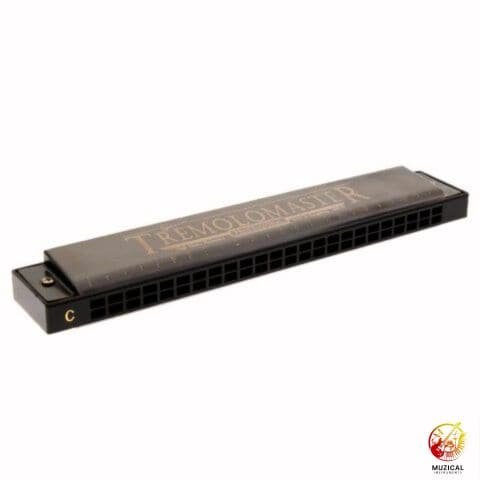
Chromatic harmonicas excel where harmonic complexity matters. Jazz musicians consider them essential for navigating sophisticated chord progressions. Classical transcriptions require the full chromatic scale. Contemporary pop often demands flexibility only chromatics provide.
Blues presents an interesting case. While most blues harp uses diatonic instruments, chromatic blues has its own tradition. Little Walter, Stevie Wonder, and Toots Thielemans proved chromatics can handle blues with unique character.
Expert Insight: Your musical influences should guide this choice. If you love traditional folk melodies, tremolo makes sense. If jazz or classical appeals to you, chromatic is almost mandatory.
What Learning Challenges Should You Expect?
The tremolo vs chromatic harmonica learning curve differs significantly. Each presents unique challenges that affect practice time and technique development.
Tremolo harmonicas offer gentler skill building. Since the vibrato happens automatically, you focus purely on melody and rhythm. The wider layout takes adjustment from diatonic playing, but most adapt quickly. Bending techniques work differently, you’re dealing with paired reeds instead of single ones.
The main challenge involves controlling the built-in effect musically. You can’t turn off the tremolo, but breath control and articulation influence how prominent it sounds. This takes time to master but doesn’t require new physical techniques.
Chromatic harmonicas demand more complex coordination. The slide button adds another layer to your playing. You’re managing breath, mouth position, and mechanical timing simultaneously. Beginning players often struggle with button coordination, pressing too early or late.
Maintenance knowledge becomes crucial with chromatics. The slide needs regular cleaning and lubrication. Understanding basic disassembly helps with long term ownership. Reed work follows similar principles to other harmonicas, but you’re dealing with twice as many reeds.
| Learning Aspect | Tremolo | Chromatic |
|---|---|---|
| Initial Difficulty | Moderate | Challenging |
| New Techniques | Tremolo control | Button coordination |
| Maintenance | Basic cleaning | Slide mechanism care |
| Practice Focus | Musical expression | Mechanical precision |
How Do Costs and Value Compare?
Budget considerations play a major role in the tremolo vs chromatic harmonica decision. Price differences reflect construction complexity and market demand.
Entry level tremolo harmonicas start around $30-50, while playable chromatics begin at $70-100. This reflects the precision needed for slide mechanisms. However, one chromatic can theoretically replace multiple diatonic harps, potentially offering better long term value.
Professional instruments show wider gaps. Quality tremolo models from Hohner, Suzuki, or Seydel cost $80-200. Professional chromatics easily reach $300-600, with custom instruments exceeding $1,000. The slide mechanism requires exceptional precision at higher quality levels.
Maintenance costs differ too. Tremolo harps need basic cleaning and occasional reed work. Chromatics require slide maintenance, often needing professional service for major issues. A slide rebuild might cost $75-150, approaching new instrument prices for budget models.
Durability varies between types. Simple tremolo construction means fewer failure points. Chromatic slides can stick or break, though quality instruments last years with proper care.
Which Harmonica Type Sounds Better?
Sound quality depends entirely on musical context. The tremolo vs chromatic harmonica tone comparison isn’t about better or worse, they serve different purposes.
Tremolo harmonicas produce rich, layered sounds. The dual reed system creates natural chorusing that makes single notes sound fuller. This works perfectly for melodic playing where emotional impact matters more than technical precision.
The tremolo effect varies by register and dynamics. Lower notes create slower, more pronounced vibrato. Higher notes produce faster, subtler effects. Breath pressure influences intensity, gentle playing emphasizes tremolo, aggressive attack minimizes it.
Chromatic harmonicas prioritize clarity and precision. Each note speaks cleanly without interference from paired reeds. This serves complex passages where every note must be distinct. The slide can create unique bending effects impossible on other harps.
Some players notice slight tonal differences between slide positions on chromatics. Quality instruments minimize this, but the effect exists. This can actually be used musically for expressive purposes.
Pro Tip: Record the same melody on both types. The tremolo version sounds atmospheric and emotional. The chromatic sounds precise and articulate. Neither is superior, they fit different musical situations.
Making Your Final Decision
Choose tremolo if you’re drawn to traditional folk music, want built in atmospheric effects, or prefer simpler maintenance. The automatic vibrato provides instant character for Celtic tunes, country ballads, or world music styles. It’s also more affordable for players exploring beyond basic diatonic harmonicas.
Choose chromatic if you need complete note access, plan to play jazz or classical music, or want maximum versatility. The learning curve is steeper and investment higher, but chromatics handle any song in any key.
Consider your musical goals honestly. Will you play traditional melodies where tremolo enhances emotional impact? Or do you want to navigate complex jazz standards requiring every sharp and flat? Your answer determines the right choice.
Many serious players own both types, using each for its strengths. Start with whichever matches your immediate interests. Mastering one harmonica type makes learning others easier later.
The tremolo vs chromatic harmonica choice shapes your musical voice for years to come. Pick the one that excites you most, that enthusiasm will carry you through the learning process and into musical satisfaction.
FAQ: Tremolo vs Chromatic Harmonica
1. What is a tremolo harmonica best used for?
A tremolo harmonica is best used for music that benefits from a rich, shimmering, chorus-like sound. It excels in genres like traditional folk music, gospel, old-time country, and certain styles of pop and Asian music. Its beautiful, wavy tone is perfect for playing melodies and is less suited for gritty, note-bending styles like the blues.
2. Is a chromatic harmonica good for beginners?
A chromatic harmonica can be challenging for absolute beginners because of the need to learn breath control and how to operate the slide button. However, for someone with a little musical background, it can be a fantastic instrument to start with because its layout is very logical and makes it easier to play in any key and read sheet music. The tremolo vs chromatic harmonica choice for a beginner often depends on their long-term musical goals.
3. Can you play blues on a chromatic harmonica?
Yes, you can definitely play blues on a chromatic harmonica. While the standard 10-hole diatonic “blues harp” is famous for its raw, bendable notes, many advanced players use the chromatic for a smoother, more jazz-influenced style of blues. It allows for complex melodies and can be played over any chord progression with ease.
4. Why does a tremolo harmonica have two rows of holes?
A tremolo harmonica has two rows of holes because it uses two reeds for every note to create its signature sound. The top row of holes corresponds to one set of reeds, and the bottom row corresponds to the second set. One set is tuned perfectly, while the other is tuned slightly sharp or flat. When you play, the air activates both reeds at once, producing the classic, wavering tremolo effect.
5. Do I need to read music to play a chromatic harmonica?
You don’t need to read music to play a chromatic harmonica, and many people learn to play wonderful music by ear. However, the instrument is designed perfectly for reading sheet music. Because the slide gives you access to all the notes, what you see on the page is exactly what you can play, which is a major advantage for learning complex songs or playing in genres like classical and jazz.
6. What is the main advantage of a chromatic harmonica over a tremolo?
The main advantage of a chromatic harmonica is its musical versatility. With the press of the slide button, you can play all 12 notes of the musical scale, allowing you to play in any key and tackle any genre. A tremolo harmonica is diatonic, meaning it is locked into a single key, making the chromatic a more complete musical instrument.
7. Is a tremolo harmonica the same as an echo harmonica?
Yes, the terms “tremolo” and “echo” are often used interchangeably for the same type of harmonica. Both names refer to the instrument with double reeds tuned slightly apart to create that wavy, pulsating, or “echoing” sound. Different brands might use one name over the other, but the underlying mechanism is the same.
